Deborah Swift's Blog, page 12
November 2, 2022
Spotlight on Squire’s Hazard by Carolyn Hughes #CoffeePotBookClub #Medieval
How do you overcome the loathing, lust and bitterness threatening you and your family’s honour?
It’s 1363, and in Steyning Castle, Sussex, Dickon de Bohun is enjoying life as a squire in the household of Earl Raoul de Fougère. Or he would be, if it weren’t for Edwin de Courtenay, who’s making his life a misery with his bullying, threatening to expose the truth about Dickon’s birth.
At home in Meonbridge for Christmas, Dickon notices how grown-up his childhood playmate, Libby Fletcher, has become since he last saw her and feels the stirrings of desire. Libby, seeing how different he is too, falls instantly in love. But as a servant to Dickon’s grandmother, Lady Margaret de Bohun, she could never be his wife.
Margery Tyler, Libby’s aunt, meeting her niece by chance, learns of her passion for young Dickon. Their conversation rekindles Margery’s long-held rancour against the de Bohuns, whom she blames for all the ills that befell her family, including her own servitude. For years she’s hidden her hunger for retribution, but she can no longer keep her hostility in check.
As the future Lord of Meonbridge, Dickon knows he must rise above de Courtenay’s loathing and intimidation, and get the better of him. And, surely, he must master his lust for Libby, so his own mother’s shocking history is not repeated? Of Margery’s bitterness, however, he has yet to learn…
Beset by the hazards these powerful and dangerous emotions bring, can young Dickon summon up the courage and resolve to overcome them?
Secrets, hatred and betrayal, but also love and courage – Squire’s Hazard, the fifth MEONBRIDGE CHRONICLE.
BUY THE BOOK #KindleUnlimited
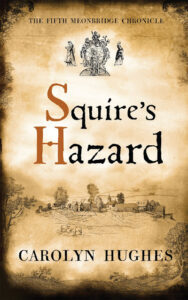 About Carolyn:
About Carolyn:
October 30, 2022
Gallows Wake by Helen Hollick #NewRelease #Pirate #Historical
Delighted to feature Helen Hollick today with the latest addition to her Piratical adventures. Helen is a massive supporter of other historical fiction authors and their books and is an ardent reader and reviewer. Here’s Helen to tell us more about GALLOWS WAKE.
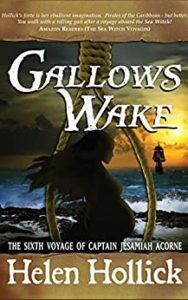 THE SEA WITCH VOYAGES of CAPTAIN JESAMIAH ACORNE
THE SEA WITCH VOYAGES of CAPTAIN JESAMIAH ACORNE
Back in 2005/6 I thoroughly enjoyed the first Pirates of the Caribbean movie – it was pure, entertaining fun. But I wanted more. I wanted the same sort of thing to read. Swashbuckling adventure-fantasy with characters to fall in love with. (I mean, who didn’t fall for Jack Sparrow?) I found plenty of ‘straight’ nautical fiction, quite a few good Young Adult piratical adventures, but nothing with that frisson of believable fantasy/supernatural entertainment for adults. So I wrote something myself. I hadn’t intended that first Voyage, Sea Witch, to expand into an entire series, but my pirate – Captain Jesamiah Acorne – became so real to me, and far,
far more intriguing than that Sparrow Fellow! I found myself wanting to delve into more adventures with him and his crew. Now, here in 2022, I have recently published the sixth Voyage, with an additional novella prequel tale as a bonus to the series. And more planned for the future.
That’s what is fascinating about a good, well-written series: the characters develop as they become your friends, and you not only want to know ‘what happens next’ but also ‘what happened previously’. I write each story to be a standalone adventure with its own plot, its own action, romance, misunderstandings, trials, tribulations and dangers, but incorporated into each story a gradual uncovering of what makes the lead characters ‘tick’ – where they came from and where they are going to. The same with a good TV series, there is the main, different plot to each episode featuring familiar and new characters, but there is also that unravelling of an ongoing, continuous thread of discovery. There is the echo of reality, of life, the new and unexpected interwoven with the familiar – but also, the unexpected. I saw the Sea Witch Voyages and Jesamiah as a compilation of fictional characters all rolled into one: Jack Sparrow, Jack Aubrey and Hornblower amalgamated with Richard Sharpe, James Bond and Indiana Jones. The sailing detail I wanted to get as spot-on accurate as I could. The touches of historical fact, maybe slightly adapted where necessary, but suitably used as a background to the plots. And I added in a believable, acceptable narrative of fantasy. Tiola, a white witch, Tethys, the spirit of the sea. Glimpses of a past life. Superstition and the supernatural. A sailor’s yarn of tales of mermaids, spirits and ghosts.
And I discovered, as the Sea Witch Voyages developed, that Jesamiah had a very interesting background to explore. [Alert: no spoilers included!] He ran away from his Virginia home at the age of almost fifteen in 1708. His mother and father were dead and he’d finally had enough of being bullied by his half-brother. He arrived at Port Royal, Jamaica, and met up with a good friend of his father’s – ostensibly a privateer aboard Mermaid. Here, Jesamiah learnt to sail, how to fight – and how to become an efficient and effective pirate. (When The Mermaid Sings). In Sea Witch (Voyage 1) we live his life as a pirate, with all its dangers and excitements. We also meet the young lady who is to become the love of his life, Tiola Oldstagh. Who is not all she seems… Their relationship is to be a tad upsy-downsy, after all, what is stronger – the love of a woman, or the love of the sea? (I’ll not say more, I promised ‘no spoilers’!) In #2 Pirate Code, Jesamiah, now an ex-pirate having accepted the King’s Amnesty, is coerced into a role he does not want – during which he is to meet the second love of his life, the spy, Francesca Escudero, and has to come to terms with the events of the past and the potentials of the future. By #3 Bring It Close, he is still in trouble – trouble follows him like a ship’s wake – but this time in trouble with Tiola and Governor Spotswood of Virginia. Against Jesamiah’s better judgement he finds himself embroiled in plans to rid the seas of the most notorious pirate of the Golden Age of Piracy – Blackbeard! There are complications, though. (1) How to placate his irate wife. (2) How to stay alive long enough to achieve 1, and (3) What to do about, and ignore, his dead father? Ghosts do not exist. Or do they? If they don’t, then who is the chap hanging around the Virginia plantation where Jesamiah grew up? The chap who seems to be keeping a close eye on
what Jesamiah is up to? And it just so happens, that much of Bring It Close is set in October – at Hallowe’en!
 THE VOYAGES
THE VOYAGES
SEA WITCH Voyage one
PIRATE CODE Voyage two
BRING IT CLOSE Voyage three
RIPPLES IN THE SAND Voyage four
ON THE ACCOUNT Voyage five
WHEN THE MERMAID SINGS A prequel to the series
GALLOWS WAKE The Sixth Voyage of Captain Jesamiah Acorne
Where the Past haunts the future…
Damage to her mast means Sea Witch has to be repaired, but the nearest shipyard is at Gibraltar. Unfortunately for Captain Jesamiah Acorne, several men he does not want to meet are also there, among them, Captain Edward Vernon of the Royal Navy, who would rather see Jesamiah hang.
Then there is the spy, Richie Tearle, and manipulative Ascham Doone who has dubious plans of his own. Plans that involve Jesamiah, who, beyond unravelling the puzzle of a dead person who may not be dead, has a priority concern regarding the wellbeing of his pregnant wife, the white witch, Tiola.
Forced to sail to England without Jesamiah, Tiola must keep herself and others close to her safe, but memories of the past, and the shadow of the gallows haunt her. Dreams disturb her, like a discordant lament at a wake. But is this the past calling, or the future?
From the first review of Gallows Wake:
“Hollick’s writing is crisp and clear, and her ear for dialogue and ability to reveal character in a few brief sentences is enviable. While several of the characters in Gallows Wake have returned from previous books, I felt no need to have read those books to understand them. The paranormal side of the story—Tiola is a white witch, with powers of precognition and more, and one of the characters is not quite human—blends with the story beautifully, handled so matter-of-factly. This is simply Jesamiah’s reality, and he accepts it, as does the reader.” Author Marian L. Thorpe.
BUY THE BOOK
Amazon Author Page (Universal link) https://viewauthor.at/HelenHollick
Where you will find the entire series waiting at anchor in your nearest Amazon harbour – do come aboard and share Jesamiah’s derring-do nautical adventures!
(available Kindle, Kindle Unlimited and in paperback) Or order a paperback copy from your local bookstore!
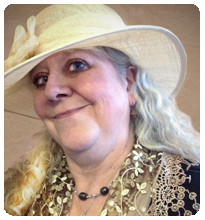 ABOUT HELEN HOLLICK
ABOUT HELEN HOLLICK
First accepted for traditional publication in 1993, Helen became a USA Today Bestseller with her historical novel, The Forever Queen (titled A Hollow Crown in the UK) with the sequel, Harold the King (US: I Am The Chosen King) being novels that explore the events that led to the Battle of Hastings in 1066. Her Pendragon’s Banner Trilogy is a fifth-century version of the Arthurian legend, and she writes a nautical adventure/fantasy series, The Sea Witch Voyages. She is now
also branching out into the quick read novella, Cosy Mystery genre with her Jan Christopher Murder Mysteries, set in the 1970s, with the first in the series, A Mirror Murder incorporating her, often hilarious, memories of working as a library assistant.
Her non-fiction books are Pirates: Truth and Tales and Life of A Smuggler. She lives with her family in an eighteenth-century farmhouse in North Devon and occasionally gets time to write…
Find Helen here:
Website: www.helenhollick.net
Newsletter Subscription: http://tinyletter.com/HelenHollick
Blog: www.ofhistoryandkings.blogspot.com
Facebook: www.facebook.com/HelenHollick
Twitter: @HelenHollick https://twitter.com/HelenHollick
October 17, 2022
The Godmother’s Secret by Elizabeth St John #PrincesInTheTower #CoffeePotBookClub
May 1483: The Tower of London. When King Edward IV dies and Lady Elysabeth Scrope delivers her young godson, Edward V, into the Tower of London to prepare for his coronation, she is engulfed in political turmoil. Within months, the prince and his brother have disappeared, Richard III is declared king, and Elysabeth’s sister Margaret Beaufort conspires with her son Henry Tudor to invade England and claim the throne.
Desperate to protect her godson, Elysabeth battles the intrigue, betrayal and power of the last medieval court, defying her Yorkist husband and her Lancastrian sister under her godmother’s sacred oath to keep Prince Edward safe. Bound by blood and rent by honour, Elysabeth is torn between the crown and her family, knowing that if her loyalty is questioned, she is in peril of losing everything—including her life.
Were the princes murdered by their uncle, Richard III? Did Margaret Beaufort mastermind their disappearance to usher in the Tudor dynasty? Or did the young boys vanish for their own safety? Of anyone at the royal court, Elysabeth has the most to lose–and the most to gain–by keeping secret the fate of the Princes in the Tower.
Inspired by England’s most enduring historical mystery, Elizabeth St.John blends her family history with known facts and centuries of speculation to create an intriguing story about what happened to the Princes in the Tower.
REVIEW
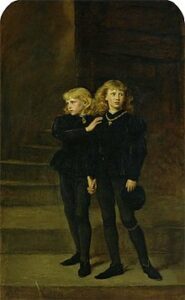
Princes in the Tower by Millais
This is a book that will thrill historical fiction fans, especially those who like their fiction based around the royal households. The novel begins with a traumatic birth, and this not only presages what is to come, but also cements the bond between Elysabeth Scrope and the infant future heir to the throne, Edward V. As the novel progresses the bond between Elisabeth and Ned is skilfully built, so that we really believe her allegiance to the young prince is her primary concern, even though this conflicts with family loyalties. Her sister Margaret Beaufort, mother to Henry Tudor is intent on advancing him instead, and abhors his exile from court.
The two women are skilfully drawn as adversaries although still siblings. In this power-torn England, the machinations behind the scenes writhe like snakes. Elysabeth has little power in that day and age to protect her charge – for example she is thrown out of the Tower, having been told her services are no longer required. She does what she can within her power, continually searching to fulfil her role as Godmother to the boy, and drawing her maidservant Meg along in her wake.
A foil to all the double-dealing is Elysabeth’s husband, Jack, a straightforward man of principle and affection who will offer her support when he can. Not so, the eventual Richard III, who seems ruthless in pursuit of power behind his reasonable facade.
The beauty of Elizabeth St John’s alternative version of events is that it reads as perfectly plausible. This is achieved by attention to detail in the clothing, food, manners and hierarchies of life at court, and in the Tower of London, and in the terse relationships between the main players in the action. Of course we all know there is a mystery behind what happened to the princes, and Elizabeh St John uses this tension to great effect.
This is a fantastic example of what a historical novelist can do – to shine a light into history, find new interpretations for past events, and to give little-known characters from history their chance to speak. A five star read that is very warmly recommended.
BUY THE BOOK Universal Link: https://geni.us/GodmothersSecret
Contact Elizabeth: www.ElizabethJStJohn.com Find her on Twitter:
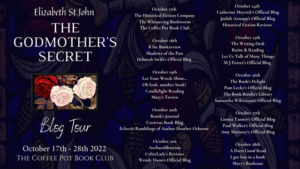 The post The Godmother’s Secret by Elizabeth St John #PrincesInTheTower #CoffeePotBookClub first appeared on Deborah Swift.
The post The Godmother’s Secret by Elizabeth St John #PrincesInTheTower #CoffeePotBookClub first appeared on Deborah Swift.
October 10, 2022
Highly Recommended Read of the Month: The Ring Breaker by Jean Gill #Viking #HistoricalFiction
About The Ring Breaker
‘A skilfully written, beautifully researched coming-of-age story set in Viking Orkney.’ Lexie Conyngham, the Orkneyinga Murders series
Loyalty has a price the children pay
In the twilight of the old gods, when the last Vikings rule the seas, two cursed orphans meet on an Orkney beach and their fates collide.
Stripped of honour, facing bleak loneliness ahead, Skarfr and Hlif forge an unbreakable bond as they come of age in the savage Viking culture of blood debts and vengeance. To be accepted as adults, Skarfr must prove himself a warrior and Hlif must learn to use women’s weapons. Can they clear their names and choose their destiny? Or are they doomed by their fathers’ acts?
The award-winning author of The Troubadours Quartet returns to the 12th century, with skalds instead of troubadours and Viking warriors instead of crusaders. Get ready for authentic medieval adventures steeped in poetry, politics and passion. Perfect for fans of Bernard Cornwell Matthew Harffy and Madeline Miller.
‘Reads from start to finish like a saga straight from a skald’s mouth.’ B.A. Morton, The Favour Bank
‘All the hallmarks of a Jean Gill novel – political intrigue, action and adventure, and a love story fraught with difficulties!’ Jane Davis, Small Eden
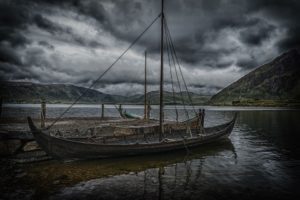
Review
A fantastic coming-of-age story. I can’t imagine historical fiction better than this – absolutely brilliant. A tour-de-force of storytelling, Viking lore, and the rugged landscape of Orkney. This was one of the highlights of my reading year. The characters of Hlif and Skarfr are brave, resourceful and intelligent and I Ioved them both. Jean Gill convinces with her well-researched, atmospheric re-construction of a far off age.
Skarfr is being trained by his cruel foster-father who wants to beat the poetry out of him and turn him into a man like himself, strong but devoid of finer feeling. His training consists of many adventures, and at first he is derided by and then supported by his friend Hilf, a girl gifted with second sight and a powerful sense of her own destiny. The book is richly detailed and the epic sea journeys over wild waves, and the land punctuated by coarse grass and ancient longbarrows is wonderfully evoked. A culture of storytelling, myth and warrior-tales, along with the struggle for political domination between two rival jarls, makes this a read full of intrigue, battle and betrayal.
I can’t wait for their next sea-faring adventure. Thank you Jean Gill for a brilliant read. When’s the next?!
BUY THE BOOK: The store of your choice
» WORLD free delivery paperback from The Book Depository – coming soon» amazon.com» amazon.co.ukContact Jean
Twitter: @writerjeangill
Website: https://jeangill.com/
The post Highly Recommended Read of the Month: The Ring Breaker by Jean Gill #Viking #HistoricalFiction first appeared on Deborah Swift.October 4, 2022
Julia Prima by Alison Morton #CoffeePotBookClub #Review #Rome #Thriller
JULIA PRIMA by Alison Morton
Blurb
“You should have trusted me. You should have given me a choice.”
AD 370, Roman frontier province of Noricum. Neither wholly married nor wholly divorced, Julia Bacausa is trapped in the power struggle between the Christian church and her pagan ruler father.
Tribune Lucius Apulius’s career is blighted by his determination to stay faithful to the Roman gods in a Christian empire. Stripped of his command in Britannia, he’s demoted to the backwater of Noricum – and encounters Julia.
Unwittingly, he takes her for a whore. When confronted by who she is, he is overcome with remorse and fear. Despite this disaster, Julia and Lucius are drawn to one another by an irresistible attraction.
But their intensifying bond is broken when Lucius is banished to Rome. Distraught, Julia gambles everything to join him. But a vengeful presence from the past overshadows her perilous journey. Following her heart’s desire brings danger she could never have envisaged…
My Review:
What a rollercoaster. I’ve been meaning to get to this series for ages, and worried that I would need to know something of the other books – but no, this book stands perfectly alone and will have you eagerly flipping the pages to find out what happens next. In Noricum, Roma Nova, its 370 AD and royal daughter Julia Bacausa lives a relaxed life with her father, who was once an elite fighter. One day at the market she is caught by surprise by her intense feelings for a Roman soldier. (Julia has been divorced by her own Pagan laws, but her Christian husband Deodatus still refuses to divorce her.) After this hot and passionate encounter she doesn’t expect to see the Roman again, but wouldn’t you know it, when the Roman commander visits, the same Roman turns up again as part of a delegation to her father. His name is Lucius Apulius, he is the commander’s Tribune, and his arrival in Julia’s life certainly brings complications. At the outset I expected Apulius to be the obvious alpha male, but through the story he turns out to be much more than that. Julia herself is bold and courageous, and unafraid to tackle anything in her way.
The novel is written in crisp vivid prose which really evokes the sights, sounds and smells of this alternative Rome. It is hard to believe the story is a fabrication because the Roman history has been so well welded to the narrative. This is a fast moving adventure with characters to believe in, plenty of travel, a fair bit of violence, and a hot and passionate romance.
I can see why this series has been highly praised and I heartily recommend Julia Prima to all who enjoy a thriller with a strong woman at its heart.
BUY THE BOOK : https://books2read.com/JULIAPRIMA
Find Alison HERE:
Alison Morton’s World of Thrillers Facebook author page Twitter
The post Julia Prima by Alison Morton #CoffeePotBookClub #Review #Rome #Thriller first appeared on Deborah Swift.October 2, 2022
Brushstrokes from the Past by Heidi Eljarbo #DualTimeline #Historical #CoffeePotBookClub
WWII and the mid-seventeenth century are entwined in this fourth dual timeline novel about Nazi art theft, bravery, friendship, and romance.
April 1945. Art historian Soli Hansen and her friend Heddy arrive at an excavation site only to find Soli’s old archeology professor deeply engrossed in an extraordinary find in a marsh. The remains of a man have lain undisturbed for three centuries, but there’s more to this discovery…
As Soli tries to understand who the baroque man was and discovers what he carried in a sealed wooden tube, problems arise. A leak reveals the finds to the notorious Lieutenant Colonel Heinz Walter, and soon, both Nazi elite and the Gestapo are after the treasure.
When Heddy and the professor disappear along with the artwork, Soli and her resistance group must find them before it’s too late.
1641. In Amsterdam, French musketeer Claude Beaulieu has had his portrait done by his close friend and artist Rembrandt van Rijn. When a band of thieves steal the precious painting, Claude and his wife Annarosa Ruber pick up their swords and a few belongings and go after the culprits.
Set in Norway during the tumultuous last days of the second world war, as well as the peak of the glorious baroque art period, these two stories are a must for readers who love historical fiction with adventure, suspense, and true love that conquers all.
Perfect for fans of Kate Morton, Lucinda Riley, Kathleen McGurl, Rhys Bowen, and Katherine Neville.
My Review
This is a story that spans the Nazi occupation of Norway and also the 17th Century art world of Amsterdam. Musketeer and emissary to Louis XIII of France, Claude Beaulieu, has a portrait painted by his friend and the renowned master Rembrandt. When the painting is stolen, Claude and his wife, the sword-wielding Annarosa Ruber decide to go after the thieves. Fast forward a few centuries, and Soli Hansen and her friend Heddy are intrigued by the findings on an archaeological dig, where a sealed tube is unearthed. So begins the fourth of these well-written adventures.
Once the contents are revealed, its not long before the Nazis also find out about what’s inside and the ruthless Gestapo will stop at nothing for possession. Many twists and turns ensue, not least the disappearance of Soli’s friends, Heddy and the Professor. Heidi Eljarbo controls the two timelines effortlessly, bringing us a true sense of period in both. As a fan of the the world of 17th Century painting, I appreciated the way it was brought to life with many tiny details that can only have been found through thorough research, such as the way letters in the 17th Century were sealed with a monogram, or the play of light on impasto brushstrokes. Soli Hansen’s relationship with her friend Heddy is warm and believable, and their Nazi antagonists suitably determined, leading to a pacy and nailbiting read. Easy to read and engrossing, this is a treat for art lovers and those who like adventure seasoned with a little romance
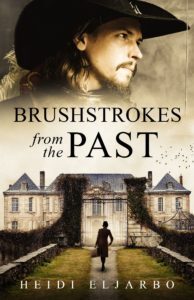 I featured Heidi’s earlier book Hidden Masterpiece here on the blog
I featured Heidi’s earlier book Hidden Masterpiece here on the blog
Available on #KindleUnlimited
BUY THE BOOK: https://books2read.com/u/47g8Ej
Contact Heidi : Amazon Author Page
Website: https://www.heidieljarbo.com/ Twitter: https://twitter.com/HeidiEljarbo
Facebook: https://www.facebook.com/authorheidieljarbo
The post Brushstrokes from the Past by Heidi Eljarbo #DualTimeline #Historical #CoffeePotBookClub first appeared on Deborah Swift.August 2, 2022
The Du Lac Chronicles by Mary Anne Yarde #Arthurian #HistoricalFiction
Spotlight on the Du Lac Chronicles – A must for fans of Arthurian Legend!
A generation after Arthur Pendragon ruled, Briton lies fragmented into warring kingdoms and principalities. Eighteen-year-old Alden du Lac ruled the tiny kingdom of Cerniw. Now he half-hangs from a wooden pole, his back lashed into a mass of bloody welts exposed to the cold of a cruel winter night. He’s to be executed come daybreak—should he survive that long. When Alden notices the shadowy figure approaching, he assumes death has come to end his pain. Instead, the daughter of his enemy, Cerdic of Wessex, frees and hides him, her motives unclear.
Annis has loved Alden since his ill-fated marriage to her Saxon cousin—a marriage that ended in blood and guilt—and she would give anything to protect him. Annis’s rescue of Alden traps them between a brutal Saxon king and Alden’s remaining allies. Meanwhile, unknown forces are carefully manipulating the ruins of Arthur’s legacy.
(Trigger warnings:Torture, Warfare)
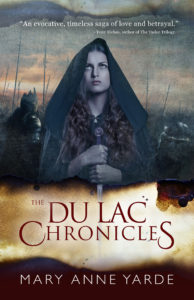 BUY THE BOOK
BUY THE BOOK
This novel is available on #KindleUnlimtied
Universal Link : https://books2read.com/u/b5lYy7
About Mary Anne Yarde
Mary Anne Yarde is a multi-award winning and bestselling author of Historical Fiction, as well as an award-winning blogger. She studied History at Cardiff University and went on to study Equine Science at Warwickshire College. Mary Anne is a passionate advocate for quality Historical Fiction and founded The Coffee Pot Book Club in 2015 and became a professional Editorial Reviewer in 2016. Mary Anne’s award-winning series, The Du Lac Chronicles, is set a generation after the fall of King Arthur. The Du Lac Chronicles takes you on a journey through Dark Age Britain and Brittany, where you will meet new friends and terrifying foes. Based on legends and historical fact, The Du Lac Chronicles is a series not to be missed
Born in Bath, England, Mary Anne grew up in the southwest of England, surrounded and influenced by centuries of history and mythology. Glastonbury—the fabled Isle of Avalon—was a mere fifteen-minute drive from her home, and tales of King Arthur and his knights were part of her childhood.
You might enjoy this interview I did with Mary Anne about the world of King Arthur – Saints, Standing Stones and an Ancient Curse
I read and enjoyed this novel a while ago – Read my review of Book One of the Du Lac Chronicles
Find Mary Anne
Website: https://authormaryanneyarde.blogspot.com/
Twitter: https://twitter.com/maryanneyarde
BookBub: https://www.bookbub.com/authors/mary-anne-yarde
July 21, 2022
Cragside: A 1930’s Murder Mystery by M J Porter #CoffeePotBookClub #MurderMystery #Extract
Dive into this 1930’s Murder Mystery!
Cragside by M J Porter – Excerpt
The following day – Lady Merryweather is now assisting Detective Inspector Aldcroft, and together they examine the scene of the murder
I step outside. The rain has finally stopped, the drip of water pooling from the roof, a reminder of just how fierce the storm has been. The sky’s a watery blue, soft clouds scudding overhead, and I huddle inside my good coat. I’ve managed to find my boots and so my feet are warm as I find myself on the very spot where Mr Harrington-Featherington had been found dead the evening before.
I’m not alone. Detective Inspector Aldcroft accompanies me. We don’t speak. It feels as though we’ve spoken a great deal, late into the evening yesterday. I’d retired to a warm bed, and slept well. I don’t think Aldcroft has been so lucky. He yawns, stifling it behind his hand, and I pretend not to see. The poor man. He must be exhausted, and now that he isn’t apprehending me on the say so of these horrible people I once thought of as friends, I almost like him.
He’s been led a merry dance by the inhabitants of the house yesterday. He’s made arrests but none of them are the killer of Mr Norman Harrington-Featherington or Lady Beatrice Carver. Or so it appears. Still, Lady Gwendoline Sunderland has been kept at Rothbury police station, and under police guard. She’s certainly not what she seems.
Despite the deluge of the night before, it’s easy to see the spot where the body was found. A dark stain mars the grey stone. It’s only a fraction of what must have bled from the man, but it’s enough to see it, and to know that someone died here.
Belatedly, I notice that Aldcroft has turned, and is gazing back at the doorway out of which we’ve just walked. Last night, I’d used the main door, as had the police officers. This area had been marked as out of bounds while Aldcroft orchestrated a thorough search, despite the heavy rainfall and the darkness. He’d hoped, he told me last night, that the weapon might be found, or some other tell-tale sign, but there had been nothing. If the murderer had left something behind, then the wind had blown it clear, or the rain had sent it spiralling down the hill to the river below us. It was probably winding it’s merry way down the stream, if it had ever existed in the first place.
I shuddered at the thought of the basin tank, where Lady Carver’s body had been found. It would be fuller than normal as well.
“I can’t see that anyone could have made their way out here, and not been seen.” Detective Inspector Aldcroft face is lined in confusion.
“The library, and the study both look out on this spot, as does the garden alcove.” I confirm.
“And the guests have made it clear that there were people in the library at the time. It would have been a terrible risk to take,” he further muses, as though I’ve not spoken.
“The actions of someone desperate.” I’m fast becoming convinced that while Lady Carver’s death might have been planned well in advance, that of Mr Harrington-Featherington’s has been opportunistic. Aldcroft has agreed with me when I’d mentioned it during our interview yesterday evening. While the remainder of the guests had been allowed into the drawing room following our dinner, they’d been watched by one of the police sergeants, essentially to ensure they weren’t attacked but really to make sure none of them could try and kill anyone else, or tamper with any evidence they might have left somewhere, if they had been the killer.
“He was definitely killed here?” I ask, just to be certain.
“He must have been. The amount of blood. I can’t see that anyone could have killed him elsewhere and dragged his body here without being noticed. Yes, it was going dark, by the time we believe he was killed, but not enough to entirely mask what was happening.”
“So the police surgeon is convinced the murder took place at dusk? At what 4pm?”
“Yes, based on what evidence he found, he is. Admittedly, it was a cold day so it’s difficult to tell.”
I walk to the edge of the rockery. From here, I can just glimpse the formal garden and greenhouses on the opposite bank of the burn.
“Surely, it would have been easier to push him over?” The fall’s huge, and almost sheer. There’s a path that winds down to the river, but it’s treacherous. I’ve made the trek many times on previous visits to the estate, but it isn’t for the faint of heart. It’s impossible to admire the view. It’s lethal to not watch your own feet.
Aldcroft stands beside me, peering down, his expression inscrutable, as he ponders my words.
“It would have made it more difficult to find the body, that’s a certainty. Yes, we’d have known he was missing, but whether he was actually dead or not would have been a mystery. Not until we found him at some point in the future. It would have meant you’d have to have been considered a suspect.” While he speaks with consideration, the words sting.
“Then I’ll be grateful for the mistake,” I try to jest, but my voice sounds edgy, even to my ears.
We’re not alone. There are two constables searching through the shrubs and plants, and in the cracks between the hard-packed earth and the grey stones. They pretend not to listen, but I’m sure they hear everything. It’s that sort of day, when sound travels in strange ways; the calm after the storm. I imagine those inside the huge house, with its mock Tudor design, are listening closely as well, especially the actual murderer or murderers. I’m yet to be unconvinced that there were two, or more of them, involved in what’s happened in such a peaceful location.
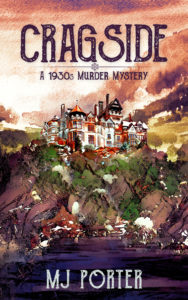 More about the book
More about the book
Lady Merryweather has had a shocking year. Apprehended for the murder of her husband the year before, and only recently released, she hopes a trip away from London will allow her to grieve. The isolated, but much loved, Cragside Estate in North Northumberland, home of her friends, Lord and Lady Bradbury, holds special memories for her. But, no sooner has she arrived than the body of one of the guests is found on the estate, and suspicion immediately turns on her. Perhaps, there are no friendships to be found here, after all.
Released, due to a lack of evidence, Lady Ella returns to Cragside only to discover a second murder has taken place in her absence, and one she can’t possibly have committed. Quickly realising that these new murders must be related to that of her beloved husband, Lady Merryweather sets out to solve the crime, once and for all. But there are many who don’t want her to succeed, and as the number of murder victims increases, the possibility that she might well be the next victim, can’t be ignored. Journey to the 1930s Cragside Estate, to a period house-party where no one is truly safe, and the estate is just as deadly as the people.
BUY THE BOOK books2read.com/Cragside
About MJ Porter
MJ Porter is the author of many historical novels set predominantly in Seventh to Eleventh-Century England, as well as three twentieth-century mysteries. Raised in the shadow of a building that was believed to house the bones of long-dead Kings of Mercia, meant that the author’s writing destiny was set.
Find M J here:
Website: https://www.mjporterauthor.com/
Blog: https://mjporterauthor.blog/
Twitter: https://twitter.com/coloursofunison
July 11, 2022
The Girl From Oto by Amy Maroney #Audiotour #audiobook #CoffeePotBookClub @wilaroney
I really enjoyed this series of books and here they are on audio, narrated by Meg Price.
Do go and get a treat of a listen!
About the first in the series:
A Renaissance-era woman artist and an American scholar. Linked by a 500-year-old mystery…
The secrets of the past are irresistible—and treacherous.
1500: Born during a time wracked by war and plague, Renaissance-era artist Mira grows up in a Pyrenees convent believing she is an orphan. When tragedy strikes, Mira learns the devastating truth about her own origins. But does she have the strength to face those who
would destroy her?
2015: Centuries later, art scholar Zari unearths traces of a mysterious young woman named Mira in two 16th-century portraits. Obsessed, Zari tracks Mira through the great cities of Europe to the pilgrim’s route of Camino de Santiago—and is stunned by what she finds. Will her discovery be enough to bring Mira’s story to life?
A powerful story and an intriguing mystery, The Girl from Oto is an unforgettable novel of obsession, passion, and human resilience.
This book is available on #KindleUnlimited.
BUY THE BOOK
The Girl from Oto: https://mybook.to/girlfromoto
Mira’s Way: https://mybook.to/MirasWay
A Place in the World: https://mybook.to/aPlaceInTheWorld

About Amy Maroney:
Amy Maroney lives in the Pacific Northwest with her family, and spent many years as a writer and editor of nonfiction before turning her hand to historical fiction. When she’s not diving down research rabbit holes, she enjoys hiking, dancing, traveling, and reading. Amy is the author of the Miramonde Series, a trilogy about a Renaissance-era female artist and the modern-day scholar on her trail. Amy’s new series, Sea and Stone Chronicles, features ordinary people seeking their fortunes under the rule of the medieval Knights Hospitaller in Rhodes, Greece. To receive a free prequel novella to the Miramonde Series, join Amy Maroney’s readers group at her website.
Website: https://www.amymaroney.com/
Twitter: @wilaroney
Facebook: https://www.facebook.com/amymaroneyauthor
The Girl from Bologna by Siobhan Daiko #Review #WW2 #CoffeePotBookClub
About the Book:
Just last week, she read Faulkner’s words, “the past is never dead. It’s not even past,” and they resonated with her. It’s true; the past is NEVER past. She can no longer bury what happened; she can no longer forget…
Bologna, Italy, 1944, and the streets are crawling with German soldiers. Nineteen-year-old Leila Venturi is shocked into joining the Resistance after her beloved best friend Rebecca, the daughter of a prominent Jewish businessman, is ruthlessly deported to a concentration camp.
In the spring of 1981, exchange student Rhiannon Hughes arrives in Bologna to study at the university. There, she rents a room from Leila, who is now middle-aged. Leila’s nephew, Gianluca, offers to show Rhiannon around but Leila warns her off him.
Soon Rhiannon finds herself being drawn into a web of intrigue. What is Gianluca’s interest in a far-right group? And how is the nefarious leader of this group connected to Leila? As dark secrets emerge from the past, Rhiannon is faced with a terrible choice. Will she take her courage into both hands and risk everything?
A heart-wrenching page-turner that will sweep you away to one of the most beautiful cities in Italy. A tale of courage, loss and heart-wrenching redemption.
 Review
Review
This is a book rich in Italian detail about Bologna; the language, the food, the architecture of the city. If you are a fan of travel to Italy, you can go there through the pages of this book and feel you are truly there. This is a thoroughly gripping read which also covers a lesser known angle on WW2. For me, the modern 1980’s part of this dual timeline story was more successful than the WW2 part of the story, I think because Leila’s WW2 story was told as a memoir, which always makes me more aware of the fact it is a story from the past. It is however very skilfully written and contains some shocking parts of Italian history which have been painstakingly researched. In Nazi-occupied Bologna there are many factions at work, including partisans, right wing activists, communists and spies and agents on both sides. What drew me into the novel was the warm relationship between the older Leila and her student lodger Rhiannon. I also appreciated the fact that Gianluca and Rhiannon become friends rather than lovers, and that the mystery of Marie (Rhiannon’s friend at the university) keeps the plot moving right until the end. I haven’t read the first two books in the series, but this one quite easily stands alone.
This is a book that will delight those who want to know more about Italy and its history, and is highly recommended.
BUY THE BOOK : Available on #KindleUnlimited
Universal Link: viewbook.at/TGFB
ABOUT Siobhan Daiko:
Siobhan Daiko is a British historical fiction author. A lover of all things Italian, she lives in the Veneto region of northern Italy with her husband, a Havanese dog and a rescued cat.After a life of romance and adventure in Hong Kong, Australia and the UK, Siobhan now spends her time indulging her love of writing and enjoying her life near Venice.
https://siobhandaiko.org
Twitter: https://twitter.com/siobhandaiko
Facebook: https://www.facebook.com/SiobhanDaikoAsolandoBooks



